Ocean Resources & Ocean Deposits, Biotic, Mineral & Energy Resources | Geography Optional for UPSC PDF Download
Ocean Resources
- The ocean is a crucial natural resource on Earth, with immense value in various aspects. It is a primary source of food, yielding around 200 billion pounds of fish and shellfish each year. This vast resource supports employment, trade, and essential services for billions of individuals worldwide.
- In addition to food, the ocean supplies numerous other resources. These include fuel, renewable energy, and minerals such as salt, sand, gravel, manganese, copper, nickel, iron, and cobalt, which can be found in the deep sea. Crude oil is also extracted through offshore drilling. Furthermore, the ocean supports the tourism industry, contributing significantly to the global economy.
 Ocean Resources
Ocean Resources
The ocean plays a critical role in removing carbon from the atmosphere and providing oxygen. It regulates Earth’s climate.
Typically Ocean Resources can be classified in to two broad categories –
- Biotic Resources
- Planktons
- Nektons
- Benthos
- Abiotic Resources
- Mineral
- Energy
Biotic Resources
- Biotic means alive and Abiotic means nonliving.
- Biotic resources of the seas include fishes, crustaceans, molluscs, corals, reptiles and mammals etc.
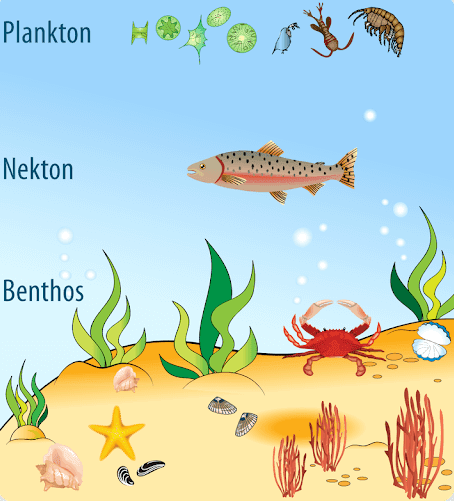 Marine Biotic Resources
Marine Biotic Resources
Planktons
Plankton are the diverse collection of organisms found in water that are unable to propel themselves against a current.
- Phytoplanktons– floating and drifting micro plants.
- Autotrophs
- Eg- algae and diatoms
- Zooplanktons– floating and drifting micro animals.
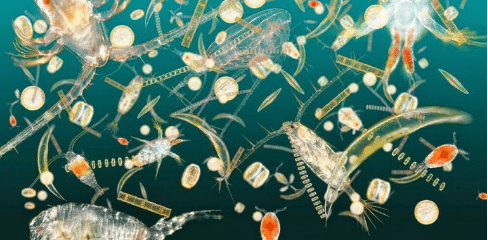 Plankton
Plankton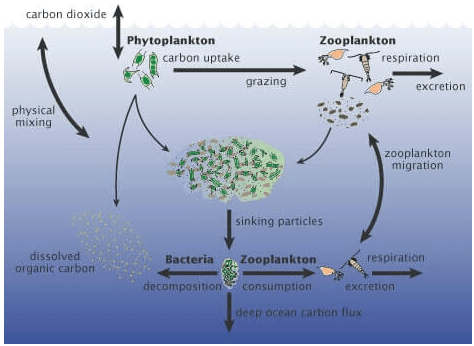 Phytoplanktons
Phytoplanktons
Nektons
Nekton (or swimmers) are living organisms that are able to swim and move independently of currents at various depths of seas and oceans.
Nektons –
- fishes
- pelagic
- demersal
- mammals
- dolphin
- Blue
- whale
Fishes
- Pelagic fish live in the pelagic zone of ocean or lake waters – being neither close to the bottom nor near the shore
- Demersal fish that live on or near the bottom.
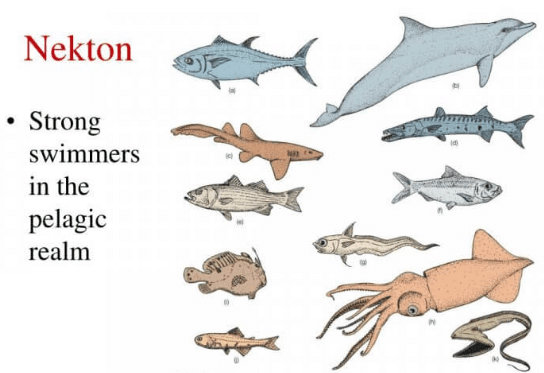 Nekton
Nekton
Benthos
Benthos refers to the collection of organisms that inhabit the bottom regions of various bodies of water, specifically the benthic zone. These creatures can be found in various environments, ranging from shallow tidal pools along the shoreline to the deeper regions of the continental shelf, and even reaching the depths of the abyssal zone. In essence, the benthos community consists of organisms that dwell on, within, or near the ocean floor or the bottom of other water bodies.
- mobile
- immobile
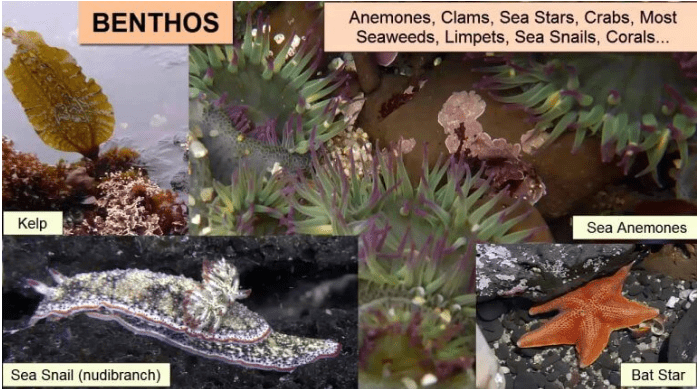 Benthos
Benthos
Mineral Reserves
- Mineral dissolved in seawater
- Continental Shelf and Slope Deposits
- Deep ocean bottom deposits
1. Mineral dissolved in sea-water
- Salt
- Bromine
- Magnesium
- Gold
- Zinc
- Uranium
- Thorium
2. Continental Shelf and Slope Deposits
- Sulfur – associated with marine volcanism.
- Ex. Gulf of Mexico – a rich source of sulfur
Magnetite reserves are found along the circum pacific volcanic belt.
- monazite sand (source of thorium) at Kerala coast
- Gold (Alaska)
- Zircon (Brazil, Australia)
- Diamond (SouthAfrica)
- Calcium-– Peruvian coast rich deposits of calcium and phosphate
- Sand and gravel – significant building materials widely found on beds of continental shelves
- Fishes are rich in nitrate and phosphate, high protein, medicinal use
- Pearls
3. Deep ocean bottom deposits
- Manganese nodules– It comprises several minerals like nickel, copper, cobalt, lead, zinc, etc.
- The maximum percentage of Iron and Manganese.
- Cobalt-rich marine deposits associated with seamounts and guyots.
- Phosphate-in form of phosphoritic modules on shallow seabeds.
- Polymetallic nodules
- Polymetallic nodules are rounded accretions of manganese and iron hydroxides that cover vast areas of the seafloor but are most abundant on abyssal plains.

 nodule polymétallique
nodule polymétallique
- Polymetallic nodules are rounded accretions of manganese and iron hydroxides that cover vast areas of the seafloor but are most abundant on abyssal plains.
Energy Reserves
- Renewable
- OTEC
- Wave
- Tidal
- Wind
- Non-Renewable
- Gas hydrates
- Mineral oil
- Natural gas
Ocean thermal energy conversion (OTEC) –
- Ocean Thermal Energy Conversion (OTEC) is a process that generates electricity by utilizing the temperature differences between deep, cold seawater and warmer, shallow or surface seawater. This temperature difference is used to operate a heat engine, which in turn produces useful work, primarily in the form of electrical power.
- However, due to the relatively small temperature differences involved, the overall thermal efficiency of OTEC systems is quite low. This presents a challenge in terms of the economic viability of large-scale implementation of this technology.
Wave Energy
- Wave energy is produced when electricity generators are placed on the surface of the ocean.
- The energy provided is most often used in desalination plants, power plants, and water pumps. Energy output is determined by wave height, wave speed, wavelength, and water density.
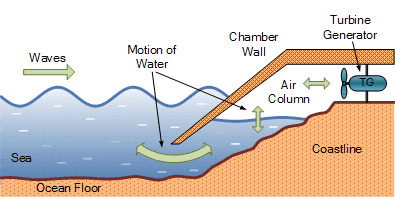 Wave Energy
Wave Energy
Tidal Energy
- Tidal energy is produced through the use of tidal energy generators.
- Large underwater turbines are placed in areas with high tidal movements and are designed to capture the kinetic motion of ocean tides in order to produce electricity.
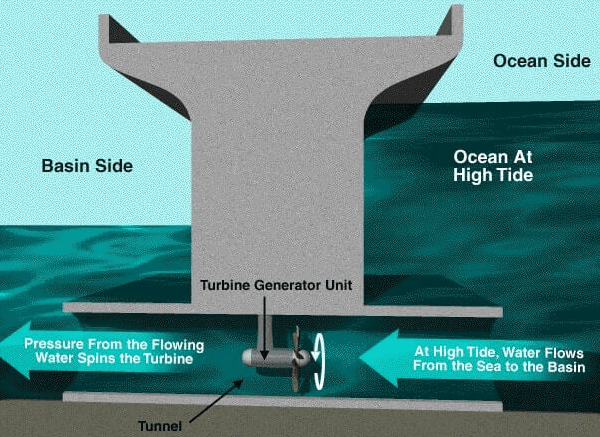 Tidal Energy
Tidal Energy
Offshore Wind Energy
- Offshore wind power or offshore wind energy refers to the construction of wind farms in bodies of water to generate electricity from wind. Stronger wind speeds are available offshore compared to on land, so offshore wind power’s contribution in terms of electricity supplied is higher.
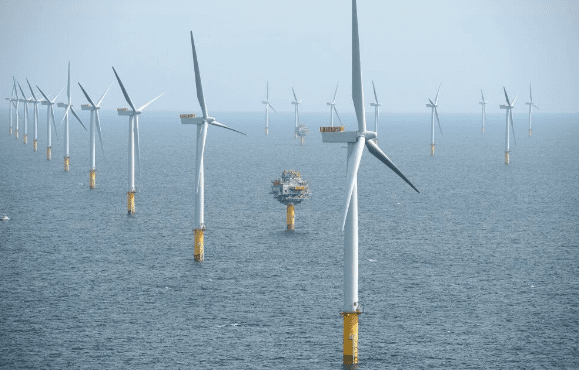 Wind Power
Wind Power
Blue Economy
The Blue Economy concept, introduced by Gunter Pauli in his 2010 book "The Blue Economy: 10 years, 100 innovations, 100 million jobs," refers to the sustainable utilization of ocean resources to promote economic growth, improve livelihoods and job opportunities, and maintain the health of ocean ecosystems. This approach encourages the implementation of environmentally friendly development strategies for increased productivity and preservation of the ocean's well-being.
The Blue Economy encompasses several key areas, including:
- Renewable Energy: Sustainable marine energy has the potential to significantly contribute to social and economic progress.
- Fisheries: By adopting sustainable fishing practices, the industry can generate higher revenues, increase fish populations, and contribute to the restoration of fish stocks.
- Maritime Transport: Sea transportation accounts for more than 80% of international trade, making it a crucial component of the global economy.
- Tourism: Ocean and coastal tourism can create employment opportunities and stimulate economic growth.
- Climate Change: Oceans act as essential carbon sinks (blue carbon) and play a crucial role in mitigating the effects of climate change.
- Waste Management: Implementing better waste management strategies on land can support ocean recovery efforts.
The Blue Economy emphasizes the need to integrate the development of the ocean economy with social inclusion, environmental sustainability, and innovative business models. This approach is reflected in the United Nations' Sustainable Development Goal (SDG 14), which aims to conserve and sustainably use the oceans, seas, and marine resources for sustainable development.
Need for Blue Economy
- Oceans play a vital role in sustaining life on Earth, as they cover 75% of the planet's surface, hold 97% of its water, and make up 99% of its habitable area. They are essential for maintaining biodiversity, regulating the climate, and absorbing approximately 30% of global CO2 emissions. Oceans also contribute significantly to the global economy, with at least 3-5% of the world's GDP generated from ocean-related activities.
- The blue economy, which focuses on the sustainable use of ocean resources, offers immense potential for enhancing economic growth by creating new opportunities for income generation and employment. This can be achieved by supporting food security and diversifying the exploitation of resources, such as renewable energy, valuable chemicals, protein-rich food, deep-sea minerals, and other aspects related to security.
- In summary, the blue economy is an emerging sector that holds great promise for the future, as it harnesses the power of the oceans to promote sustainable development and economic growth.
Challenges
- The risk of maritime terrorism and criminal activities: Piracy, armed robbery, and maritime terrorism, along with illegal trade in crude oil, weapons, drugs, and human trafficking, as well as the smuggling of contraband, pose significant threats to the safety and security of the maritime domain.
- Natural disasters: Every year, numerous tsunamis, cyclones, hurricanes, and typhoons wreak havoc on coastal communities, leaving thousands of people displaced and causing extensive damage to property and infrastructure.
- Man-made issues: Oil spills and climate change have ongoing repercussions on the stability of the marine environment, posing hazards to both ecosystems and the human populations that rely on them.
- Effects of climate change: As sea temperatures and acidity levels fluctuate, marine life, habitats, and the communities that depend on them face increasing threats to their survival and well-being.
- Marine pollution: The release of excess nutrients from sources such as untreated sewage, agricultural runoff, and marine debris like plastics contributes to the deterioration of the marine environment.
- Overexploitation of marine resources: The illegal, unreported, and unregulated extraction of marine resources is a pressing issue that leads to the depletion of valuable species and ecosystems.
Blue Economy for India
- The blue economy offers an unparalleled opportunity for India to achieve its national socio-economic goals and enhance connectivity with neighboring countries. By focusing on generating livelihoods, ensuring energy security, building ecological resilience, and improving the health and living standards of coastal communities, the blue economy can play a crucial role in India's development.
- The implementation of the blue economy will support the Indian government's efforts to achieve the Sustainable Development Goals (SDGs) of eradicating hunger and poverty, as well as promoting the sustainable use of marine resources by 2030. With a coastline spanning 7,517 km across nine states and two union territories, India's Exclusive Economic Zone (EEZ) covers an area of 2.02 million square kilometers.
- The marine services sector has the potential to form the backbone of India's blue economy, contributing significantly to the country's goal of becoming a 5 trillion dollar economy by 2025. The Indian Ocean, which serves as a major trade route with approximately 80% of global oil trade passing through it, is a key area for India to focus on.
- Enhancing regional connectivity will not only reduce transportation costs and maritime wastage of resources, but also promote sustainable and cost-effective trade. In summary, the blue economy presents a unique opportunity for India to achieve its socio-economic objectives while fostering stronger regional connections and promoting sustainable development.
Developments Initiated by India
India has initiated several developments to enhance its maritime sector, such as the Sagarmala Project, which is a strategic initiative aimed at port-led development through the extensive use of IT-enabled services for modernizing ports. This project aims to revolutionize maritime logistics by developing inland waterways and coastal shipping, which will create millions of new jobs, reduce logistics costs, and more.- One of the main focuses of the Sagarmala Project is the sustainable development of coastal communities and the people living in them. This includes promoting the responsible use of ocean resources, introducing modern fishing techniques, and developing coastal tourism.
- Under the umbrella of the Ocean Services, Modelling, Application, Resources, and Technology (O-SMART) scheme, India aims to regulate the use of oceans and marine resources for sustainable development. Additionally, the Integrated Coastal Zone Management (ICZM) project focuses on conserving coastal and marine resources and improving livelihood opportunities for coastal communities.
- The development of Coastal Economic Zones (CEZ) under the Sagarmala Project is expected to become a key component of the blue economy, wherein industries and townships that rely on the sea will contribute to global trade.
- Furthermore, India has implemented a National Fisheries Policy to promote the 'Blue Growth Initiative,' which emphasizes the sustainable utilization of fisheries wealth from marine and other aquatic resources. Overall, these initiatives reflect India's commitment to developing its maritime sector in a sustainable and responsible manner, benefiting both the environment and the people who depend on it.
Conclusion
The ocean is a vital resource that offers significant economic, ecological, and societal benefits. The blue economy concept emphasizes the sustainable use of ocean resources to promote economic growth, improve livelihoods, and maintain the health of marine ecosystems. India, with its extensive coastline and strategic location in the Indian Ocean, has the potential to harness the blue economy for socio-economic development, environmental sustainability, and regional connectivity. Through initiatives such as the Sagarmala Project, O-SMART scheme, and the National Fisheries Policy, India is working towards realizing the full potential of its maritime sector while ensuring the well-being of coastal communities and the preservation of marine resources.Frequently Asked Questions (FAQs) of Ocean Resources & Ocean Deposits, Biotic, Mineral & Energy Resources
What is the blue economy?
The blue economy refers to the sustainable utilization of ocean resources to promote economic growth, improve livelihoods and job opportunities, and maintain the health of ocean ecosystems. It encompasses renewable energy, fisheries, maritime transport, tourism, climate change mitigation, and waste management.
How does the blue economy contribute to sustainable development?
The blue economy emphasizes the need to integrate the development of the ocean economy with social inclusion, environmental sustainability, and innovative business models. This approach supports the United Nations' Sustainable Development Goal (SDG 14), which aims to conserve and sustainably use the oceans, seas, and marine resources for sustainable development.
What are some renewable energy sources derived from the ocean?
Ocean-based renewable energy sources include ocean thermal energy conversion (OTEC), wave energy, tidal energy, and offshore wind energy. These technologies harness the power of temperature differences, waves, tides, and wind to generate electricity.
What are the challenges faced by the blue economy?
Challenges faced by the blue economy include maritime terrorism and criminal activities, natural disasters, man-made environmental issues, climate change impacts on marine life and habitats, marine pollution, and overexploitation of marine resources.
How is India working towards developing its blue economy?
India is focusing on key initiatives such as the Sagarmala Project for port-led development, Ocean Services, Modelling, Application, Resources, and Technology (O-SMART) scheme for regulating the use of oceans and marine resources, Integrated Coastal Zone Management (ICZM) project for coastal and marine resource conservation, and the development of Coastal Economic Zones (CEZ) to contribute to global trade.
|
303 videos|635 docs|252 tests
|
FAQs on Ocean Resources & Ocean Deposits, Biotic, Mineral & Energy Resources - Geography Optional for UPSC
| 1. What are ocean resources? |  |
| 2. What are biotic resources? |  |
| 3. What are mineral reserves in the ocean? |  |
| 4. What are energy reserves in the ocean? |  |
| 5. What developments have been initiated by India in ocean resource utilization? |  |

















